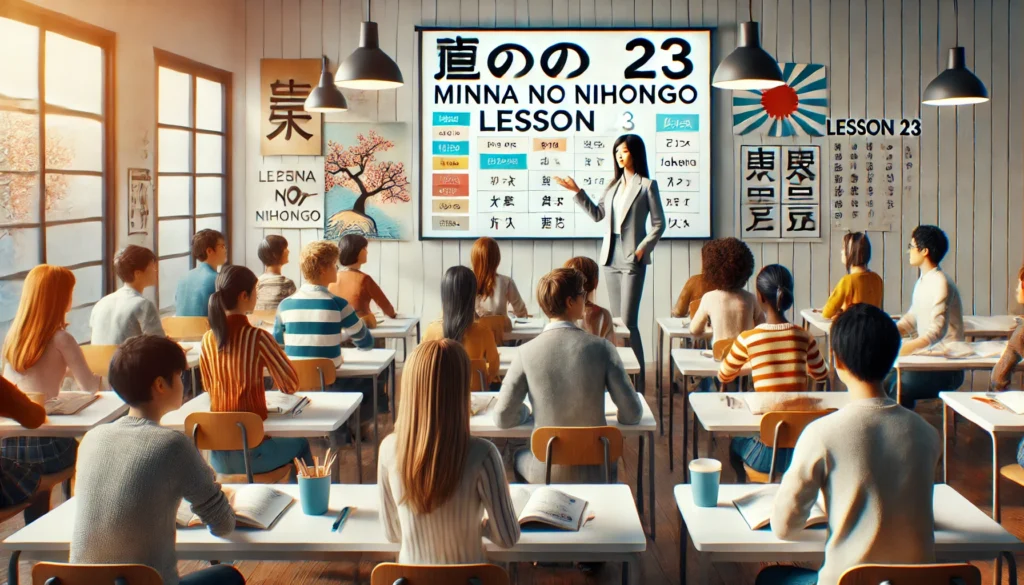Minna no Nihongo Lesson 23 vocabulary takes learners a step closer to mastering practical Japanese. The focus of this lesson is on essential vocabulary and grammar structures that pertain to preferences, abilities, and decision-making. This article breaks down the key vocabulary, sentence patterns, and practical usage tips to help you excel.
Read More: Minna no Nihongo N5 Listening.
Minna No Nihongo Lesson 23 Vocabulary Practice
A complete table introducing the Lesson 23 vocabulary is provided below.
| Japanese (Kanji/Kana) | Romaji | English Meaning |
|---|---|---|
| 聞きます (聞く) | kikimasu / kiku | To ask; to listen |
| 回します (回す) | mawashimasu / mawasu | To turn |
| 引きます (引く) | hikimasu / hiku | To pull |
| 変えます (変える) | kaemasu / kaeru | To change |
| 触ります (触る) | sawarimasu / sawaru | To touch |
| 出ます (出る) | demasu / deru | To come out |
| 動きます (動く) | ugokimasu / ugoku | To move |
| 歩きます (歩く) | arukimasu / aruku | To walk |
| 渡ります (渡る) | watarimasu / wataru | To cross |
| 気をつけます (気をつける) | ki o tsukemasu / ki o tsukeru | To be careful |
| 引っ越しします (引っ越しする) | hikkoshi shimasu / hikkoshi suru | To move (house) |
| 電気 | denki | Electricity; light |
| サイズ | saizu | Size |
| 音 | oto | Sound |
| 機械 | kikai | Machine |
| 故障 | koshō | Breakdown |
| 道 | michi | Road; way |
| 交差点 | kōsaten | Intersection |
| 橋 | hashi | Bridge |
| 駐車場 | chūshajō | Parking lot |
| 順番 | junban | Order; sequence |
| 説明 | setsumei | Explanation |
| 案内 | annai | Guidance; information |
| 信号 | shingō | Traffic light |
| 故障します (故障する) | koshō shimasu / koshō suru | To break down |
| 押します (押す) | oshimasu / osu | To push |
| 曲がります (曲がる) | magarimasu / magaru | To turn (direction) |
| 外します (外す) | hazushimasu / hazusu | To remove |
| 調べます (調べる) | shirabemasu / shiraberu | To investigate |
| 渡します (渡す) | watashimasu / watasu | To hand over |
| 付けます (付ける) | tsukemasu / tsukeru | To attach |
| 始まります (始まる) | hajimarimasu / hajimaru | To begin |
| 終わります (終わる) | owarimasu / owaru | To end |
| 戻ります (戻る) | modorimasu / modoru | To return |
| 届きます (届く) | todokimasu / todoku | To reach; to arrive |
| 止まります (止まる) | tomarimasu / tomaru | To stop |
| 準備 | junbi | Preparation |
| 決めます (決める) | kimemasu / kimeru | To decide |
| 使えます (使える) | tsukaemasu / tsukaeru | To be usable |

Common Sentence Patterns in Lesson 23
1. Asking Questions with 聞きます (kikimasu):
- Example: 先生に聞きます。 (Sensei ni kikimasu.)
- Meaning: I ask the teacher.
2. Expressing Movement with 渡ります (watarimasu):
- Example: 橋を渡ります。 (Hashi o watarimasu.)
- Meaning: I cross the bridge.
3. Being Careful with 気をつけます (ki o tsukemasu):
- Example: 道を渡る時、気をつけます。 (Michi o wataru toki, ki o tsukemasu.)
- Meaning: I am careful when crossing the road.
Practical Tips for Learning Vocabulary
- Visualize the Words: Connect vocabulary with images to create mental associations.
- Practice Situational Usage: Incorporate words into everyday scenarios to reinforce memory.
- Leverage Audio Resources: Listening to native pronunciation improves comprehension and recall.
FAQs about Minna no Nihongo Lesson 23
What is the focus of Lesson 23 in Minna no Nihongo?
Lesson 23 focuses on vocabulary and grammar related to asking questions, describing movement, and giving warnings or advice.
How can I effectively memorize the vocabulary?
Using mnemonic devices and associating words with daily activities can help in retention.
Are there additional resources to complement Lesson 23?
Yes, consider using flashcards, language apps, and audio recordings for comprehensive learning.

Conclusion
Lesson 23 of Minna no Nihongo equips learners with vocabulary and expressions essential for navigating daily conversations and scenarios. By mastering the words and sentence patterns provided, you can confidently expand your linguistic abilities and cultural understanding.